Historical Figures
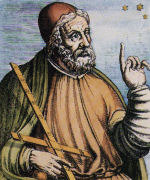
Claudius Ptolemy
c. 90 - 168
Ptolemy was the most influential astronomer, geographer, and mathematician of ancient times.
He lived in Alexandria, Egypt which
was a major center of knowledge of the ancient Mediteranean.
He promoted the (geocentric) idea that the Earth was the center of the Universe and that all
things revolved around it. This theory prevailed for the next 1400 years.
The writings of Ptolemy include names and outlines of 48
constellations
that are still in use today.
|
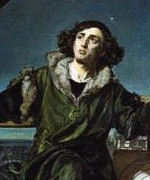
Nicolaus Copernicus
1473 - 1543
Copernicus wrote a treatment on the solar system that suggested that the Sun was more
likely to be in the center than the Earth. It is named "On the Revolutions of the Heavenly Bodies."
The idea of a heliocentric or sun-centered system is considered so important to history
that it is often referred to as the "Copernican Revolution." Once we accept that the Sun is a star,
we immediately are confronted with the possibility that the galaxy is filled with suns and planets.
From then on, whenever we look into space, we realize that
someone may be looking back.
|
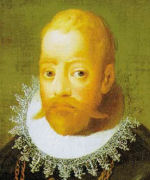
Tycho Brahe
1546 - 1601
A Danish nobleman and official Imperial Astronomer to Rudolph II of Prague (before telescopes), he used a "quadrant" to precisely
measure the positions of celestial objects, especially
Mars.
This data would later prove crucial to Kepler in
formulating the laws of planetary motion.
He observed a supernova and showed that it could not be within our atmosphere.
Likewise he showed that comets must be farther away than the Moon.
To say the least, Brahe was a colorful character. He got into an argument over a
math question which led to a knife fight and part of his nose was cut off.
He had a gold and silver replacement made and carried around a box of glue to keep it
stuck on.
|
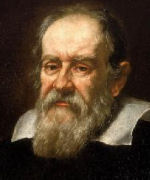
Galileo Galilei
1564 - 1642
Galileo formulated the basic law that all falling bodies fall at the same rate.
Notably, he verified his conclusions by carefully designed experiments and measurements.
He constructed a
refractor telescope
with
which he viewed craters on the Moon, the phases of Venus, and the rings of Saturn.
He discovered four moons revolving around Jupiter. He agreed with Copernicus that
the Earth and other planets revolved around the Sun. For promoting this and other science, he was
arrested and tried for heresy by the Roman Catholic Church.
|
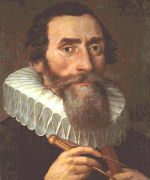
Johannes Kepler
1571 - 1630
Kepler "broke the code" of planetary orbits. After the death of Tycho Brahe he was appointed successor
as the Imperial Astronomer and Mathematician. Using Brahe's meticulous notes on the positions of Mars he was able
to deduce that the planets orbit around the Sun, but in ellipses, not circles as Copernicus
had assumed. Kepler articulated three
laws of planetary motion. 1. Planets travel in ellipses
with the Sun at one focus of the ellipse. 2. An imaginary line between a planet and the Sun sweeps
out equal area in equal time.
3. The square of the total time period of an orbit is proportional to the cube of the average
distance of the planet to the Sun.
|
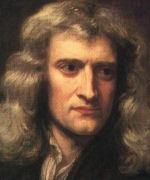
Isaac Newton
1642 - 1727
Listing all of Newton's contributions to science would fill volumes. For the science of astronomy
certain areas of work stand out. He designed a new
type of
reflecting telescope
which is now called a "Newtonian" telescope. Most amateur telescopes
in use today are
Newtonians. He used a prism to show that white light is actually made of colors.
His laws of motion and gravity are the basis for understanding Kepler's laws of
planetary orbits.
|
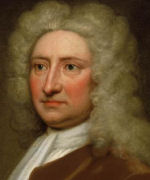
Edmund Halley
1656-1742
Among his many studies are tides, magnetism, and trade winds.
He cataloged 341 southern hemisphere stars and discovered a star
cluster in Centaurus. He also made the first complete observation of a
transit of Mercury on November 7, 1677.
He also invented the diving bell. But his most famous accomplishment is that he worked out a theory of
the orbits of comets,
concluding that the comet of 1682
(which still bears his name) was periodic, and that it would
return in 76 years. Halley had died by the time the comet returned but the success of the prediction
greatly elevated the level of confidence people had in the power of science.
|
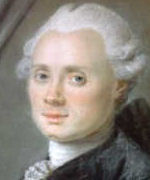
Charles Messier
1730 - 1817
Messier was a comet-hunting French astronomer who sought to
catalog
the location of deepsky objects that
could easily be mistaken for comets in small telescopes.
His list contains a few more than 100 diffuse objects. The actual number is controversial because of
problems with identifying certain objects. M40 may not exist at all, or at best is a dim double star
pair. M102 is probably a duplicate entry of M101.
Today the list is considered the sky's very best showpiece objects for deepsky enthusiasts. All the objects can be seen with small amateur telescopes and many can be seen with binoculars. |
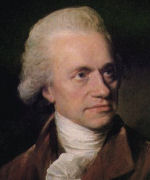
William Herschel
1738 - 1822
The discoveries Herschel made are many. He built a 48-inch telescope which was the world's largest
for more than 50 years.
He discovered what he first thought was a comet, but turned out to be planet
Uranus.
Eventually he also discovered two moons of Uranus; Titania and Oberon, and two moons of Saturn;
Enceladus and Mimas.
He determined that our solar system is moving in the direction of Hercules.
He went on to catalog about 2500 deep sky objects. The Astronomical League
has designated some of these for observing programs such as the
Herschel 400 Club.
|
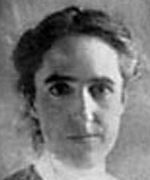
Henrietta Leavitt
1868 - 1921
Studying variable stars in the Magellanic Clouds, she discovered that certain variable stars have
a cycle that corresponds to their luminosity; the brighter the star, the
longer the period. Using this relationship, she was able to determine that the intrinsic
brightness of these stars is predictable. By comparing that value to the apparent brightness,
the difference can then be used to calculate their distance from Earth.
This method became an important yardstick for measuring the size of the
Milky Way
as well as the distance to nearby galaxies.
|
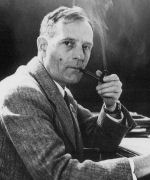
Edwin Hubble
1889 - 1953
Before Hubble's big discovery many astronomers thought our Milky Way was the whole Universe. The
Andromeda Galaxy was called the Andromeda Nebula.
Some had speculated about external "island universes" but Hubble found the proof.
Not only did he show that there are
giant systems of stars outside the Milky Way (which we now call galaxies), but
Hubble's Law
explains how the galaxies are receding away from each other. This movement suggests the Universe is getting bigger.
If it is getting bigger, that means it use to be smaller. This discovery led astronomers to the
Big Bang Theory
which is a model that astronomers have high confidence in today.
|
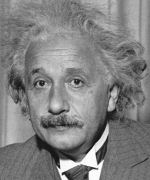
Albert Einstein
1879 - 1955
The contributions that Einstein gave to the astronomical community are so significant
that the depth of some them are still
being explored today. Some of the areas of major impact concern the nature of light, gravity, and time.
It is in regards to the nature of light that Einstein received a Nobel Prize. He explained the "photoelectric effect." The essence of this work is that the amount of energy contained in various light waves are directly related to the light's wavelengths. For example, blue light is more energetic than red. Einstein gave us a whole new perspective on gravity called General Relativity. Instead of viewing gravity as an attractive force between two objects (like Newton), he viewed it as a shape. By treating space itself as a thing with shape that can be distorted in the vicinity of matter, he gave us a powerful tool for explaining extreme situations and effects, like black holes. The strange nature of time is explained in Einstein's Theory of Special Relativity. It shows how time is not absolute, but elastic, stretching or compressing depending on the individual observer's point of view. As bizarre as that may seem, this is one of the most tested and successful theories in history. |